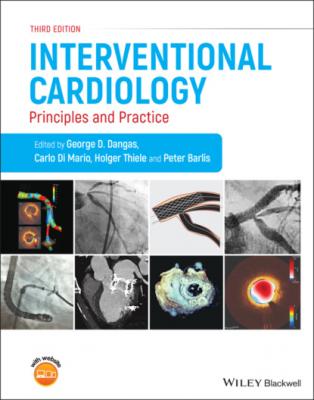Interventional Cardiology. Группа авторов
Читать онлайн.| Название | Interventional Cardiology |
|---|---|
| Автор произведения | Группа авторов |
| Жанр | Медицина |
| Серия | |
| Издательство | Медицина |
| Год выпуска | 0 |
| isbn | 9781119697381 |
As a general rule, endorsed by an AHA consensus of experts [25], in all patients considered for a vascular closure device a femoral angiogram should be performed in order to assess the anatomic suitability for its use (puncture site, vessel diameter, atherosclerosis, calcification, etc). The use of vascular closure devices is generally discouraged if the diameter of the common femoral artery is less than 6 mm or if the arterial sheath entry is located below the femoral artery bifurcation or above the inferior hypogastric artery.
AngioSeal
The AngioSeal device consists of a rectangular absorbable copolymeric anchor deployed intravascularly against the arterial wall which is attached by an absorbable Dexon traction suture to an extravascular collagen plug applied to the outside of the arterial wall. The AngioSeal assembly consists of a carrier system with the anchor, collagen plug, and traction suture compacted at the distal end. There is a delivery sheath with a modified locator dilator which identifies when the sheath is intravascular. After cardiac catheterization, the working sheath is changed over to the AngioSeal delivery sheath. Once the delivery sheath is intravascular, as indicated by pulsatile flow in the arteriotomy locator system of the dilator, the dilator and wire are removed. The carrier is then advanced into the sheath, locks in place with the sheath, and then the entire assembly is withdrawn until resistance is felt. This indicates apposition of the anchor on the luminal arterial wall. Further withdrawal releases the collagen plug on the external surface of the artery, followed by a tamper tube. The tamper tube is used to compress the plug over the wire, followed by removal of the tamper tube and cutting of the suture, which are external to the patient. Currently, the AngioSeal is available in two sizes: 6 and 8 Fr. Deployment success rates ranged from 92% to 98%, and hemostasis success ranged from 84% to 97% [26].
Perclose
The Perclose device is a suture‐mediated system which has undergone a steady evolution which included the Techstar device, Closer S 6 Fr, and the current ProGlide 6 Fr system. It incorporates two needles in the proximal compartment of the device and a catheter that houses the suture (Figure 2.5). The working sheath is exchanged over a wire for the Perclose device. The device is advanced until return of pulsatile blood in the locator, indicating appropriate intravascular placement. A lever is pulled to open the “feet,” and the device is withdrawn until resistance is felt, indicating apposition of the foot processes and suture catch plates against the inner vessel wall. A plunger is depressed, forcing the needles through the outer vessel wall into the suture catch plates. The catch plates are attached to the ends of the suture. Retraction of the plunger withdraws the needles and the attached sutures through the skin. With the current ProGlide system, the device incorporates a non‐absorbable polypropylene monofilament with pre‐tied knot that is tightened, and the vascular access site closed using a pusher device. One significant advantage of the Perclose system is to maintain access to the vessel during deploying the device by using the guidewire before withdrawing the device. Therefore, the wire can be reintroduced via the device after the needle and suture deployment, and the wire removed after confirmation of adequate hemostasis. This feature is unique among the closure approaches. In most series, the device is successfully deployed in 89–100%, with hemostasis success seen in 86–99%. The Prostar device is a Perclose‐based suture mediated device, which allows for closure of larger arteriotomy. It comes in 8 or 10 Fr and can incorporate one or two sutures (associated with two or four needles, respectively). The Prostar device have been extensively used in the early TAVR era for arteriotomy suture‐mediated closure. However, in the more recent experience the use of two ProGlide devices inserted forming a St Andrew’s cross compared with Prostar was associated with significantly lower rates of closure device failure, minor and major bleedings, lower major vascular complications and possibly also lower in‐hospital mortality rates [27, 28].
Figure 2.5 The Perclose ProGlide device is used to deliver sutures through the puncture to close the arteriotomy site. The small insets of the upper left of the figure show feet that are opened inside the artery, and the mechanism by which needles are driven from the handle of the device into the feet to capture the sutures. The sutures are then withdrawn using the needles, and a pre‐tied knot is pushed through the skin to the top of the arteriotomy site on the outside of the artery.
StarClose
StarClose is a device that applies a 4‐mm low profile nitinol clip entirely on the external surface of the artery with no permanent intravascular component (Figures 2.6 and 2.7). The tines of the clip grasp the arterial tissue and close the arteriotomy in a purse string fashion. The device consists of the clip applier and a proprietary 6 Fr sheath. After conclusion of cardiac catheterization, the working sheath is changed over a wire to the proprietary sheath, with further blunt dissection during the process to ease subsequent advancement of the 12 Fr clip applier through the skin and subcutaneous tissue. The clip applier has a vessel locator, which is inserted into the sheath, until the clip applier snaps into the sheath. A button is depressed which deploys small flexible nitinol wings at the end of the vessel locator, inside the artery. The entire assembly is withdrawn
